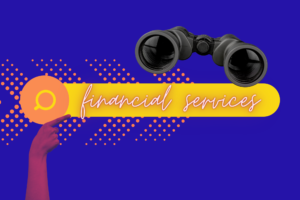Table of Contents
Last Updated on July 2, 2020 by admin
In the last article, we talked about some great written content ideas for fintechs to consider. Blog posts, white papers, and case studies all serve a number of purposes, including educating people about your products and services, generating leads, and enabling your audience to keep a pulse on the industry.
Written content, however, isn’t the only tool in a fintech’s arsenal. Hybrid content that spans across media can serve similar purposes and engage an audience on multiple channels. The examples below are the different types of unique, ROI-driven content assets along with tips on how to make the most of each.
Unique Content Ideas
Hybrid content that works across multiple channels or that incorporates multiple types of content (e.g. written and visual) can be highly effective in reaching a wide audience. Mixing text and design elements adds visual appeal and can be a more engaging route for audiences that do not have the time or patience to read through longer-form content. It’s also good to vary media throughout your brand storytelling and communications as a way to keep your brand fresh and dynamic.
Infographics
Infographics are a particularly compelling type of content because they appeal to your audience’s visual sense. Allowing people to process information visually—or at least offering the option to—can help your content marketing (and overall marketing) perform amazingly well. Whether in lieu of or in addition to, visual cues like icons, illustrations, and graphics can help distill complex ideas into a digestible format. This is especially helpful in an industry like fintech, which is rife with data and statistics that are best served in a visual way. Infographics are incredibly flexible and can be used and reused throughout a content marketing plan, making them prime ROI-driven content pieces.
Maximizing ROI-Driven Content Like Infographics:
- Add an embed code so that others can easily share the infographic on their sites.
- Leverage an in-house designer or freelancer to create infographics or use one of Canva’s templates.
- Grab data or statistics from a recent white paper and create an infographic to share on social, driving your audience to the landing page for the white paper
- Gather data from high profile sources to create your infographic (e.g. Top 25 Fintechs to Watch in 2019). Consider Aberdeen, Gartner, and Forrester.
- Create blog posts around particularly compelling infographics
- Include as a highlight in enewsletters
- Include links to your top 3-4 blog posts in your enewsletter
- When sharing on social, tag the sources you used to create your infographics; they may be apt to share since you are crediting their research.
eBooks
eBooks can be similar to white papers but often have more branding and visual elements and illustrations. Their function is similar: they can be gated by landing pages with form fills to generate leads. As visual elements, they are also easily repurposed and broken down into smaller, more bite-size pieces that can be used across channels.
Maximizing ROI-Driven Content Like eBooks:
- Repurpose an ebook into a SlideShare with clickable page buttons for easy viewing.
- Print for or share with sales teams to use as sales collateral/aids.
- Consider sharing an un-gated version with your email subscribers.
- Chop sections or pages of the ebook into standalone graphics or blog posts and share on social channels.
- Add a pop-up eBook banner to your blog to capture email addresses in exchange for the ebook.
- Add a slider promoting the eBook to your homepage slider (where applicable) or promote in a sidebar callout.
- Use snippets from the eBook to answer relevant questions on Quora to promote the entire ebook.
Social Media Posts
Social media caters to visual elements. It’s an opportunity to get creative and let the quirkier, vibrant side of your brand shine. The types of content you post will vary by individual channel (e.g. Facebook may be great for posting .gifs or memes, whereas LinkedIn is good for infographics grounded in data). You have an opportunity to extend your reach if you can be creative. The more creative, the more likes and share, and the greater the chances of going viral. Likes, shares, and comments are also measurable and a great way to assess performance on social channels.
Maximizing ROI-Driven Content With Social Media:
- Focus on using teasers from longer-form content to drive traffic back to the full version on your website.
- Avoid salesy language or images and instead gear social posts toward spurring conversation.
- Utilize “poll” features where available to engage your audience and gain valuable insights into their preferences.
- Consider using social channels to promote your own surveys, perhaps incentivizing people with a gift card or other item they value.
- Leverage custom tabs on Facebook to replicate landing pages for high-quality content assets
Email Newsletters
Newsletters are a way to keep your audience engaged and abreast with industry insights and company news. Unfortunately, many enewsletters today are drab, unappealing, and useless to subscribers. The key to creating great enewsletters is finding balance. First and foremost, there needs to be balance between text and visual elements. While all-text emails may have higher deliverability scores, they are also no fun to read. On the other hand, an email that could double as a print flyer can often be overwhelming or impersonal to recipients. Visuals are an important element in email newsletters, but they must convey meaning. Use only high-quality, informational images contribute to overall messaging rather than distract from it. Function and legibility are key. A thoughtful, well-designed enewsletter can go a long way to getting subscribers to take the action you want them to take.
Maximizing ROI-Driven Content With Email Newsletters:
- Link to top performing blog posts in enewsletters to keep readers informed and engaged.
- Use an email deliverability test tool to gauge whether or not your enewsletters are getting caught in spam.
- Include “forward to a friend” options so readers can easily share your content with others.
- Consider a/b testing different designs and content (test one element at a time) to see how different visuals and messaging perform.
- Easily allow people to change their email preferences and always include an unsubscribe option.
ROI-driven content that leverages text and visual elements can be a powerful ingredient to fintech marketing. High-quality content doesn’t always mean long-form cnontent, and weaving in visual elements can increase engagement and broaden reach. Many pieces of log-form fintech content can be repurposed or distributed via some of the ideas we have discussed here. Missed Part I? You can view it here.




